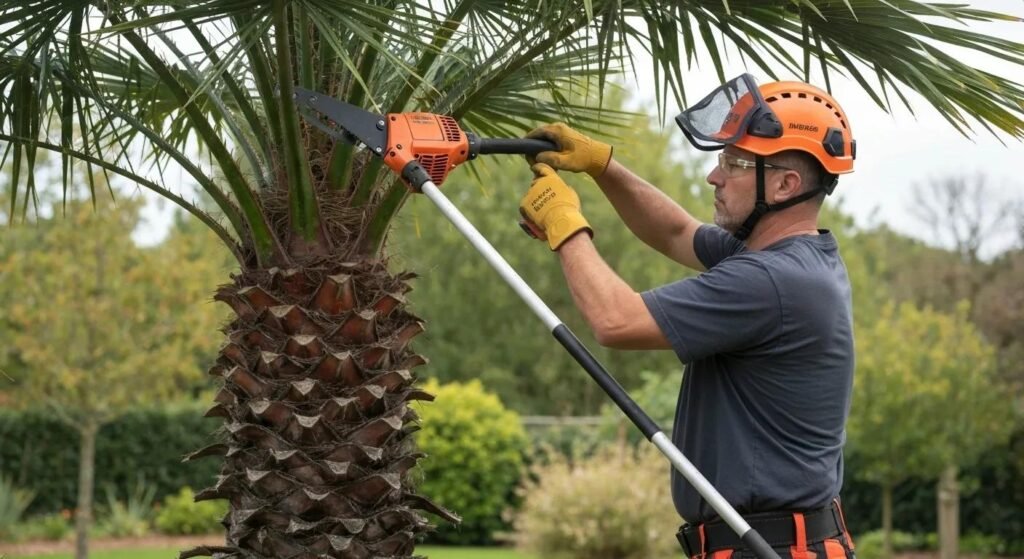Best Practices for Palm Tree Maintenance in Port Orange: Expert Care Tips for Healthy, Safe Palms
Regular neglect of palm trees in Port Orange can lead to hazards, pest infestations, and declining curb appeal. This guide provides the best palm tree maintenance practices to help property owners improve tree health, enhance safety, and preserve landscape value. It outlines why routine care matters, trimming techniques, fertilization schedules, disease and pest management, removal protocols, cost factors, and professional service selection. Florida Tree Service professionals combine local expertise and certified arborist skills to deliver reliable results and peace of mind.
Why Is Regular Palm Tree Maintenance Essential in Port Orange?
Regular palm tree maintenance is the scheduled process of pruning, fertilization, and inspection that prevents hazards, promotes vigorous growth, and reduces disease risk. For example, removing dead fronds decreases wind resistance and safeguards roofs during storms. Consistent care extends palm longevity and enhances landscape aesthetics in Port Orange’s subtropical environment.
Palm Tree Maintenance Importance
Regular palm tree maintenance, including pruning and fertilization, is essential for preventing hazards, promoting healthy growth, and reducing the risk of diseases. This proactive care extends the lifespan of palm trees and enhances the overall aesthetic of the landscape, particularly in subtropical environments.
Florida Department of Agriculture and Consumer Services
What Safety Hazards Do Untrimmed Palm Trees Pose During Hurricane Season?
Untrimmed palm trees pose serious safety hazards as dead fronds and seed pods can detach in high winds, striking structures or people.
- Falling fronds can damage vehicles, roofs, and power lines.
- Excessive wind resistance may increase the risk of palm damage or uprooting.
- Detached debris becomes dangerous projectiles during storms.
Clearing dead material early reduces storm damage and ensures safer properties year-round.
How Does Palm Tree Care Enhance Property Value and Curb Appeal?
Proper palm tree care enhances property value by creating uniform, healthy canopies that attract buyers and complement architectural design.
- Well-maintained palms establish a polished landscape appearance.
- Vigorous growth signals attentive property stewardship.
- Pruned forms highlight architectural lines and entryways.
Investing in routine maintenance boosts curb appeal and delivers measurable return on landscaping investments.
What Are the Effects of Port Orange’s Subtropical Climate on Palm Tree Health?
Port Orange’s subtropical climate influences palm tree health through heat, humidity, and seasonal rainfall that affect water and nutrient balance.
- High humidity fosters fungal pathogens like Ganoderma butt rot.
- Intense sun exposure can scorch understory fronds.
- Heavy rains contribute to root-zone waterlogging and root rot.
Adapting maintenance to these conditions prevents environmental stress and supports robust palms.
What Are the Best Palm Tree Trimming Techniques for Port Orange Palms?

Effective palm tree trimming removes dead or hazardous fronds while preserving healthy canopy structure to improve wind resistance and aesthetic shape. For example, selective removal of brown fronds at the crown reduces wind load without over-thinning live foliage. Applying proper cuts enhances healing and supports sustained growth.
How Often Should Palm Trees Be Trimmed in Port Orange?
Palm trees in Port Orange should be trimmed once or twice annually to remove dead fronds, seed stalks, and flower clusters. Performing a light pruning in late spring and a thorough clean-up in early autumn aligns with growth cycles and hurricane preparedness. This schedule promotes healthy frond production and minimizes storm damage.
What Is the Difference Between the “Hurricane Cut” and “Pineapple Cut”?
Below is a comparison of two common trimming techniques used by professionals:
| Cut Technique | Cut Description | Structural Impact |
|---|---|---|
| Hurricane Cut | Removes most old fronds and seed stalks quickly | Reduces wind resistance but can stress the crown if overdone |
| Pineapple Cut | Leaves a tight skirt of old fronds at the base | Protects trunk from sunburn and shock |
While the hurricane cut lowers wind load, the pineapple cut maintains insulation around the trunk and supports natural healing.
What Safety Measures Should Be Taken During Palm Tree Trimming?
Proper safety measures prevent falls and injuries when trimming tall palms and include:
- Wearing a certified harness, helmet, eye protection, and gloves.
- Securing ladders or using aerial lifts with stabilizers.
- Clearing the work zone of bystanders and obstacles.
- Consulting a certified arborist for trees over 20 feet high.
Adhering to safety protocols protects property and personnel.
Which Tools Are Recommended for Effective Palm Tree Pruning?
Pruning palms requires the right equipment to produce clean cuts and reduce infection risk. Recommended tools include:
- A pole pruner with rotational head for high fronds.
- A sharp pruning saw or curved blade for thick petioles.
- Protective chaps and cut-resistant gloves for personal safety.
- A shoulder-strap harness when using a pruning saw aloft.
- Hand shears for fine trimming at lower heights.
How Should Palm Trees Be Fertilized for Optimal Health in Port Orange?
Palm tree fertilization is the targeted application of nutrients that supports root development, frond expansion, and disease resistance. A balanced slow-release palm formula prevents common deficiencies in Port Orange’s sandy soils—for instance, applying an 8–2–12 NPK mix with micronutrients feeds new growth and strengthens stress tolerance.
Palm Tree Fertilization
Fertilization is a key aspect of palm tree care, with specific nutrient deficiencies common in Florida palms. Applying a balanced, slow-release palm formula, such as an 8-2-12 NPK mix with micronutrients, helps to address these deficiencies and support the overall health and stress tolerance of the trees.
University of Florida IFAS Extension, “Fertilizing Palms” (2023)
What Nutrient Deficiencies Are Common in Florida Palm Trees?
Common nutrient deficiencies manifest as visible frond discoloration and include:
- Magnesium deficiency causing yellow striping on older fronds.
- Potassium deficiency leading to brown leaf tips and spotting.
- Manganese deficiency showing distinct yellow mottling on young leaves.
- Iron deficiency resulting in uniform yellowing of new fronds.
Which Fertilizer Types Are Best Suited for Port Orange Palm Species?
Property owners can choose from these palm-specific fertilizers:
| Fertilizer Type | Key Nutrients | Application Benefit |
|---|---|---|
| Slow-Release Granular | NPK 8-2-12 + micros | Delivers nutrients over 3–4 months |
| Water-Soluble Palm Mix | NPK 12-4-12 + trace | Quick correction of acute deficiencies |
| Organic Palm Blend | Compost + sea kelp | Improves soil structure and microbial health |
What Is the Recommended Fertilization Schedule for Palm Trees?
A quarterly fertilization schedule aligns with growth spurts and seasonal stressors:
- Early spring (March–April) to support new frond emergence.
- Mid-summer (June–July) to counter heat and drought stress.
- Early autumn (September–October) ahead of hurricane season.
- Late winter (January–February) for soil nutrient recharge.
Sticking to this rhythm maximizes nutrient availability and frond vitality.
How Can Property Owners Recognize Signs of Nutrient Deficiency?
Signs of deficiency appear in frond development patterns:
- Yellowing between frond veins signals magnesium or iron shortage.
- Browning at leaf edges indicates potassium or calcium imbalance.
- Slow leaf emergence and stunted growth reveal general malnourishment.
- Pale new fronds with chlorotic spotting point to micronutrient gaps.
Optimize Palm Tree Care for a Healthy, Safe Landscape in Port Orange

Identifying diseases and pests relies on observing specific symptoms and implementing targeted treatments. For instance, spotting frond wilting from Fusarium wilt early allows trunk-injection fungicides to limit spread and preserve surrounding palms.
What Are the Symptoms of Fusarium Wilt, Lethal Yellowing, and Ganoderma Butt Rot?
| Disease | Visible Symptoms | Impact on Palm |
|---|---|---|
| Fusarium Wilt | One-sided frond wilting and browning | Gradual crown collapse |
| Lethal Yellowing | Yellowing of immature fronds followed by death | Rapid palm mortality |
| Ganoderma Butt Rot | Mushroom-like conks at trunk base | Structural failure and decay |
Which Pests Commonly Affect Palm Trees in Port Orange?
Several insect pests compromise palm health in subtropical climates:
- Palm weevils bore into trunks and crowns.
- Scale insects suck sap and weaken fronds.
- Spider mites create fine webbing under fronds.
- Aphids cluster on new growth causing leaf curling.
What Are Effective Prevention and Treatment Options for Palm Tree Diseases?
Preventive and corrective measures include:
- Applying trunk-injection fungicides to curb root-borne pathogens.
- Using horticultural oils or insecticidal soaps for scale and mites.
- Removing and disposing of infected fronds to reduce inoculum sources.
- Maintaining optimum soil moisture and drainage to limit fungal growth.
When Should You Consult a Professional for Disease or Pest Issues?
Consult a certified arborist when:
- Disease symptoms progress despite home treatments.
- Pest populations exceed control thresholds on multiple fronds.
- Large or historic palms require specialized injection equipment.
- Local regulations mandate licensed applicators for certain chemicals.
When and How Should Palm Trees Be Safely Removed or Stump Ground in Port Orange?
Safe palm removal and stump grinding prevents property damage, eliminates hazards, and readies sites for replanting. For example, removing a leaning Queen Palm showing root rot and grinding its stump reduces tripping risks and removes decay sources.
What Are the Signs That Palm Tree Removal Is Necessary?
Removal may be warranted when:
- The trunk leans dangerously close to structures or sidewalks.
- Extensive Ganoderma rot compromises structural integrity.
- Severe storm damage leaves irreparable crown loss.
- Redevelopment or hardscaping requires a clear site.
How Is Safe Palm Tree Removal and Stump Grinding Performed?
| Step | Key Action | Safety Measure |
|---|---|---|
| Tree Assessment | Inspect health, lean, and utility lines | Wear helmet and eye protection |
| Rigging and Cutting | Section trunk with chainsaws and lifts | Use certified arborist and trained crew |
| Stump Grinding | Grind 6–12 inches below grade | Control debris and protect lawn |
| Site Restoration | Backfill hole and reseed or mulch | Ensure proper soil compaction |
What Local Regulations Affect Palm Tree Removal in Port Orange?
Port Orange enforces regulations to protect public safety and urban canopy:
- Removal permits are required for palms over 12 inches in diameter.
- Certain native species may need approval or replacement planting.
- Waste disposal must follow county green-waste guidelines.
Compliance avoids fines and supports municipal tree-management goals.
What Factors Influence the Cost of Palm Tree Maintenance Services in Port Orange?
Service costs vary based on tree characteristics, site conditions, and scope of work. Taller palms require specialized equipment and labor, while densely planted areas add time and logistical complexity. Understanding cost drivers helps property owners budget accurately.
How Do Tree Height, Condition, and Accessibility Affect Service Costs?
- Taller palms demand lifts or climbing gear, increasing labor hours.
- Diseased or decaying trunks require careful rigging and disposal.
- Limited access or steep terrain calls for additional equipment setup.
These factors translate directly into resource allocation and price adjustments.
What Are Typical Price Ranges for Common Palm Tree Services?
| Service Type | Average Price Range | Typical Scope |
|---|---|---|
| Routine Trimming | $150–$300 per tree | Dead frond removal, cleanup |
| Fertilization Application | $75–$150 per treatment | Quarterly granular or liquid feed |
| Disease Treatment Injection | $200–$400 per injection | Trunk fungicide or nutrient boost |
| Full Removal & Stump Grinding | $400–$800 per tree | Sectional removal and stump grind |
How Can Property Owners Get Accurate Quotes for Palm Tree Care?
Property owners secure precise estimates by:
- Scheduling an on-site assessment with measurements and site photos.
- Requesting written proposals detailing scope, materials, and timelines.
- Verifying ISA certification and insurance coverage of the provider.
- Comparing multiple bids while weighing experience and reputation.
Transparent quotes ensure no hidden fees and align expectations.
How Do You Choose a Professional Palm Tree Service in Port Orange?
Selecting a reputable palm tree service guarantees safe, effective care that enhances landscape value. Engaging an ISA certified arborist provides expert diagnosis, proper technique, and compliance with local codes, resulting in healthier, more attractive palms.
Why Is Hiring an ISA Certified Arborist Important for Palm Tree Care?
Hiring an ISA certified arborist ensures:
- Expert knowledge of palm biology and disease management.
- Safe rigging and pruning methods for complex tree work.
- Accurate disease diagnosis and treatment recommendations.
- Adherence to industry safety standards and best practices.
What Licensing and Insurance Should a Reliable Tree Service Have?
A trustworthy service maintains:
- General liability insurance covering property damage.
- Workers’ compensation for on-site personnel safety.
- Valid Port Orange business license for local compliance.
- ISA certification proof and safety training records.
What Questions Should Property Owners Ask Before Hiring a Palm Tree Service?
Before hiring, ask about:
- Years of palm care experience and local project examples.
- References and before-after photos of completed work.
- Detailed safety protocols and emergency response plans.
- Warranty or follow-up services for pruning and treatments.
How Does Local Reputation Impact Service Quality?
Local reputation reflects consistent satisfaction and trustworthiness:
- Positive reviews confirm dependable service delivery.
- Word-of-mouth referrals highlight customer loyalty.
- Repeat contracts indicate quality and reliability.
- Community involvement demonstrates commitment to Port Orange’s canopy.
Healthy, well-maintained palm trees protect property, enhance curb appeal, and thrive in Port Orange’s subtropical climate. Implementing the best palm tree maintenance practices outlined here—and partnering with experienced professionals—ensures vibrant, resilient landscapes. For reliable service and expert guidance, contact Florida Tree Service or explore options for expert palm tree care in Port Orange.
